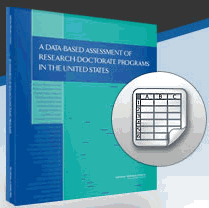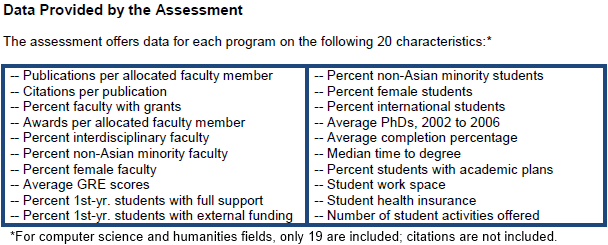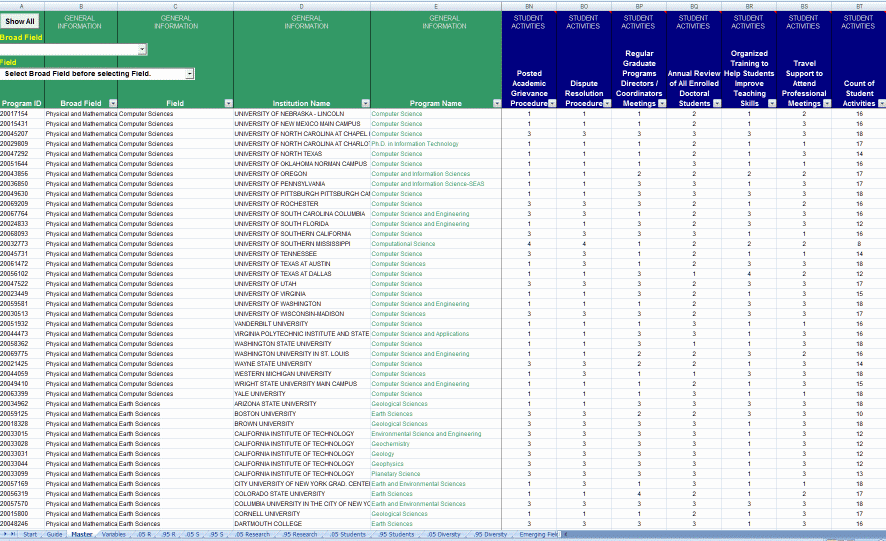|
|
|
|
|
|
|
News & Views item - August 2011 |
![]() US National Academies Issues Evaluation of 5,000 US Doctorate Programs.
(August 3, 2011)
US National Academies Issues Evaluation of 5,000 US Doctorate Programs.
(August 3, 2011)
 The
US National Academies have released A Data-Based Assessment of
Research-Doctorate Programs in the United States (2011). The 322-page
document and accompanying Excel spreadsheet in several formats are
available online where a series of 8-demos are available to
help in accessing the material.
The
US National Academies have released A Data-Based Assessment of
Research-Doctorate Programs in the United States (2011). The 322-page
document and accompanying Excel spreadsheet in several formats are
available online where a series of 8-demos are available to
help in accessing the material.
The editors, Jeremiah P. Ostriker, Charlotte V. Kuh, and James A. Voytuk, write: "A Data-Based Assessment of Research-Doctorate Programs in the United States presents findings from data collected for the 2005-2006 academic year from more than 5,000 doctoral programs at 212 universities. This report also includes illustrations of how the data can be used to produce rankings of doctoral programs based on measures important to faculty, students, administrators, funders, and other stakeholders. ...[The] resource allows evaluation and comparison of programs in areas such as faculty research activity, student support and outcomes, and diversity of the academic environment."

A 4-page "Report
in Brief"![]() describes how the data were collected and illustrates the use of the data.
Overall the report analyses and ranks:
describes how the data were collected and illustrates the use of the data.
Overall the report analyses and ranks:
Research Activity: These rankings reflect program characteristics such as publications, citations, the percent of faculty holding research grants, and recognition through honours and awards. Faculty in science and engineering fields placed the greatest weight on grants per faculty member. Faculty in the humanities and social sciences generally placed the greatest weight on publications. Both groups valued honours and awards.
Student support and outcomes: These rankings reflect program characteristics such as the percent of students fully funded in the first year, the percent of students completing their degrees in a given time period, and expected placement in academic positions. Surveyed faculty tended to place more importance on student support and completion rates than on time to degree or placement.
Diversity of the academic environment: These rankings reflect characteristics such as the percent of faculty and students from underrepresented minority groups, the percent of faculty and students who are female, and the percent of students who are international. Faculty in most fields placed the most weight on the percent of students from underrepresented minority groups.
The Report in Brief concludes with the "Findings and Trends in [US] Doctoral Education".
The report also examines trends in U.S. doctoral education since the National
Research Council's last assessment was released in 1995, based on data collected
in 1993. Comparisons are limited to programs that participated in both studies.
The number of students enrolled has increased in engineering (4%) and in physical sciences (9%) but declined in the social sciences (-5%) and humanities (-12%).
On average programs in all fields have experienced a growth in the percentage of female students. The smallest growth (3.4%) was in the humanities fields, which were already heavily female, while the greatest growth (9%) was in engineering -- to 22% overall.
The percentage of Ph.D.s awarded to students from underrepresented minority groups has increased for all fields. For example, minority Ph.D.s increased from 5.2% to 10.1% in engineering, and from 5% to 14.4% in the social sciences.
As was found in the 1995 report, larger programs tend to be more highly ranked. This result holds despite the current study's primary reliance on per capita measures of scholarly productivity.
The report also offers general findings on graduate education in the U.S., including the following:
Doctoral education is dominated by public universities, which housed 72% of the doctoral programs ranked in the study. Of the 37 universities that produced the most Ph.D.s from 2002-2006, only 12 were private universities.
The faculty is not diverse with respect to underrepresented minorities, who make up 5% or less of faculty in all broad fields except the social sciences (7%) and the humanities (11%).
Over 50% of students complete their degree in six years or less in the agricultural sciences and in engineering. In the social sciences 37% complete in six years or less, which is the same percentage of humanities students who complete by eight years.
The majority of students in five fields surveyed for the report -- chemical engineering, physics, neuroscience, economics, and English -- were "very satisfied" or "somewhat satisfied" with the quality of their program. Over 60% in most fields felt they benefited from the program's intellectual environment, but only 40% or less of were satisfied with the program-sponsored social interaction.
Below is the appearance (55% reduced) of the window of a concatenation of the Excel spreadsheet. The full spread sheet runs from column A through column BT, rows 2 through 5005.
